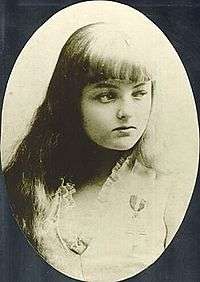Elvira Madigan


Elvira Madigan (4 December 1867 – 19 July 1889) was the stage name of a Danish tightrope walker and trick rider, whose illicit affair and dramatic death were the subject of the Swedish film of 1967.
Early life
She was born Hedvig Antoinette Isabella Eleonore Jensen in Flensburg in the Kingdom of Prussia (now in northern Germany). Her mother was a Norwegian / Finnish circus performer. She was 17 years old and unmarried when she had Elvira. Her father was a Danish acrobat, Frederik Jensen, who died a few years later.[1] Her mother then met the American circus artist and later circus manager John Madigan. They lived together for many years and eventually formed their own circus troupe, Circus Madigan, before marrying.[2]
Tragedy
While performing in Sweden with her stepfather's circus, she met a Swedish nobleman and cavalry officer at the Royal Scanian Dragoon Regiment, Lieutenant Bengt Edvard Sixten Sparre af Rossvik (27 September 1854 – 19 July 1889). Sparre and Madigan fell in love, but their love was impossible since Sparre was from a different social class. He was also married and the father of two children, but his marriage had been unhappy, according to his father. After exchanging love letters for more than two years, they ran away together to Denmark in June 1889, where they spent about a month at a hotel in Svendborg. When circus Bergman arrived in Svendborg where her half-brother Oscar had been a member for many years, they hastily went for a longer excursion and took the ferry to the nearby island of Tåsinge.
They stayed at a little pension in the fishing village of Troense where they sat in a gazebo in the garden. They carved their names and hearts in the table; "Sixten Hedvig — Ett hjerteminne".
Sparre wrote to the Svendborg hotel from Tåsinge, informing them that they would be back on Thursday, July 18. However, when no financial help was forthcoming from his family, their last hope disappeared.[3] On July 18, a picnic meal was prepared. They went out to the Nørreskov ("North forest") on the Tåsinge and had a last meal, after which Sparre probably shot Madigan and himself with his service revolver on 19 July 1889 (the place is marked by a greyish pink granite stone at 55°00′18″N 10°38′02″E / 55.00506°N 10.63377°E). Madigan was 21 years old and Sparre 34 years old.
Madigan's and Sparre's grave is situated in the cemetery of Landet on Tåsinge and is still today visited by tourists and lovers from all over the world. Their tragic love story has some resemblance to the Austrian Mayerling drama, in which the Crown Prince Rudolf of Austria and his lover took their lives in January 1889. Elvira's mother said that Elvira was affected by this, and shortly before she ran away she had asked her which way to die was best, drowning or shooting.[4]
Film adaptations
The story of Elvira Madigan and Sixten Sparre has been the subject of three films. The 1967 Swedish film, directed by Bo Widerberg, is the best known. The soundtrack features the Andante from Piano Concerto No. 21 in C (K 467) by Mozart, which is sometimes informally referred to as the "Elvira Madigan" Concerto. There was a Danish film made the same year, and had been an earlier Swedish film in 1943.
Musical influence
- In 1889, Johan Lindström Saxon wrote an extremely popular Swedish ballad called 'Sorgeliga Saker Hända', or simply 'Elvira Madigan'.
- The Swedish pop band Komeda recorded an original song "Elvira Madigan" on their third English album Kokomemedada.
- The English folk band Mr. Fox recorded their song "Elvira Madigan" on their second album, The Gipsy.
- The Chicago chamber pop duo The Heavy Boxes recorded their own song "Elvira Madigan (Walkin' a Tightrope)" on their second EP, "History Is Made At Night".
- Elvira Madigan is also the name of a Swedish symphonic black metal band.
- The Danish folkmusic band Dræsinebanden has made a song (in Danish) about Elvira Madigan and Sixten Sparre called Elvira og Sixten
See also
References
- ↑ Grönqvist, Klas (2013). En droppe föll – En bok om Elvira Madigan. Norsborg: Recito. Libris 14840445. ISBN 978-91-7517-506-5
- ↑ Grönqvist, Klas (2013). En droppe föll – En bok om Elvira Madigan. Norsborg: Recito. Libris 14840445. ISBN 978-91-7517-506-5
- ↑ Grönqvist, Klas (2013). En droppe föll – En bok om Elvira Madigan. Norsborg: Recito. Libris 14840445. ISBN 978-91-7517-506-5
- ↑ "Familjen Madigan". Retrieved 17 July 2016.
External links
 Media related to Elvira Madigan at Wikimedia Commons
Media related to Elvira Madigan at Wikimedia Commons- Elvira Madigan's Gravesite
- Elvira Madigan and Sixten Sparre - Love and Tragedy https://elviramadigansixtensparre.wordpress.com/2015/04/11/elvira-madigan-sixten-sparre/